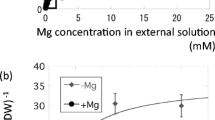Abstract
WORK with many kinds of plants has shown that the uptake of rubidium is often so similar to the uptake of potassium that rubidium-86 can be used as a tracer for potassium1. MacRobbie and Dainty2, however, found that in the alga Nitellopsis the fluxes of rubidium at the plasmalemma were less than those of potassium. It was suggested2 that rubidium was unable to take part in active transport mechanisms in the same manner as potassium. Adrian3 has also shown that the permeability of frog muscle fibres to rubidium is much less than their permeability to potassium.
Similar content being viewed by others
References
Epstein, E., and Hagen, C. E., Plant Physiol., 27, 457 (1952).
MacRobbie, E. A. C., and Dainty, J., J. Gen. Physiol., 42, 335 (1958).
Adrian, R. H., J. Physiol., 175, 134 (1964).
Dodd, W. A., Pitman, M. G., and West, K. R., Austral. J. Biol. Sci., 19, 341 (1966).
Bonting, S. L., and Caravaggio, L. L., Biochim. Biophys. Acta, 112, 519 (1966).
Author information
Authors and Affiliations
Rights and permissions
About this article
Cite this article
WEST, K., PITMAN, M. Rubidium as a Tracer for Potassium in the Marine Algae Ulva lactuca L. and Chaetomorpha darwinii (Hooker) Kuetzing. Nature 214, 1262–1263 (1967). https://doi.org/10.1038/2141262a0
Received:
Issue Date:
DOI: https://doi.org/10.1038/2141262a0
- Springer Nature Limited
This article is cited by
-
Selective bioaccumulation of rubidium by microalgae from industrial wastewater containing rubidium and lithium
Journal of Applied Phycology (2018)
-
Potassium transport in Chlamydomonas reinhardtii: isolation and characterization of transport-deficient mutant strains
Planta (1985)
-
Electrogenic pump activity in red beet: Its relation to ATP levels and to cation influx
The Journal of Membrane Biology (1980)
-
Rb86 as tracer for potassium: I. Uptake of Rb and K by rice plant in nutrient solution
Plant and Soil (1971)
-
Der Influx von Kaliumionen bei Bl�ttern von Elodea densa, Abh�ngigkeit vom Licht, von der Kaliumkonzentration und von der Temperatur
Planta (1970)





